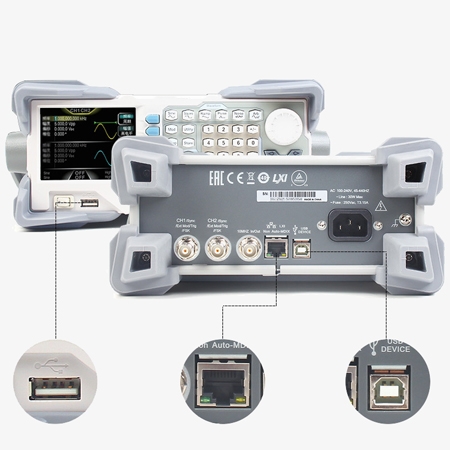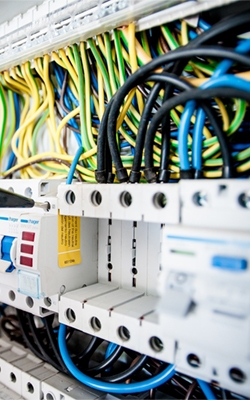SISCO arbitrary wave generator is a dual-channel waveform generator with 1 μHz resolution. The high-speed arbitrary waveform generator is a multifunctional generator that integrates multiple functions, including a function generator, arbitrary waveform generator, noise generator, pulse generator, harmonic generator, analog/digital modulator and counter.

- The arbitrary waveform generator design with a 3.5-inch TFT color LCD display, which displays the menu and parameter settings of the current function, system status, prompt messages, etc.
- Equal-performance dual channels are standard, equivalent to two independent signal sources.
- Up to 160 built-in arbitrary waveforms, covering commonly used signals in various fields such as engineering applications, medical electronics, automotive electronics, and mathematical processing.
- Powerful arbitrary waveform editing function is standard, and arbitrary waveforms can also be generated through the host computer software.

- The AWG generator is equipped with standard configuration interfaces including USB Host, USB Device, LAN (LXI Core 2011 Device).
- Rich modulation functions, AM, FM, PM, ASK, FSK, PSK and PWM.
- Standard waveform superposition function, which can superimpose the specified waveform on the basic waveform and then output it.
- Standard channel tracking function, when tracking is turned on, all parameters of the two channels can be updated simultaneously according to the user's configuration.
Dimension

Applications
SISCO arbitrary waveform generator (AWG) is versatile and widely used in various fields. It can simulate complex communication signals, test and develop electronic components and circuits, generate biomedical signals for medical device testing, simulate automotive sensor outputs, and test radar and sonar systems in aerospace and defense. Additionally, AWGs are used in audio equipment testing, acoustic research, educational tools, industrial automation, power quality testing, and renewable energy systems. They are essential for precise and customizable signal generation, making them invaluable for development, testing, and research in multiple domains.

Power Quality Testing

Industrial Automation

Equipment Testing

Audio Equipment Testing
| Model | SISCO-AWG-DG1032Z |
| Basic Parameters | |
| Maximum Output Frequency | 30 MHz |
| Sampling Rate | 200 MSa/s |
| Vertical Resolution | 14 bits |
| Number of Channels | 2 |
| Arbitrary Wavelength | 8M, 3.5-inch TFT color display |
| Display | Clear graphical interface |
| Instrument Function | |
| Built-in Waveform | 5 basic waveforms, 160 arbitrary waveforms |
| Frequency Characteristics | Sine wave: 1 μHz-30 MHz Square wave: 1 μHz-25 MHz Sawtooth wave/triangle wave: 1 μHz-500 kHz Pulse wave: 1 μHz-15 MHz |
| Resolution | 1 μHz |
| Amplitude Range (50Ω) | 2.5 mVpp-10 Vpp (≤10 MHz); 2.5 mVpp-5 Vpp (>10 MHz) |
| Modulation Function | AM, FM, PM, ASK, FSK, PSK, PWM |
| Sweep Waveform | Sine wave, square wave, sawtooth wave, arbitrary wave (except DC) |
| Burst Waveform | Sine wave, square wave, sawtooth wave, pulse wave, noise, arbitrary wave (except DC) |
| Frequency meter Function | 1 μHz-200 MHz |
| Other Configurations | |
| Harmonic Generator Function | Support 8th harmonic generator |
| Standard Interface | USB host, USB device, LAN ( LXI-C) |
Detail
- Power button
- USB Host
- Menu page key
- Return to the previous menu
- CH1 output connector
- CH2 output connector
- Channel control area
- Counter measurement signal input connector
- Frequency meter
- Direction keys
- Knob
- Numeric keyboard
- Waveform key
- Function key
- Menu soft key
- LCD display

Q1: What is an Arbitrary Waveform Generator (AWG)?
A1: An Arbitrary Waveform Generator (AWG) is a device that generates user-defined, complex waveforms. It allows for the creation and output of a wide variety of signal shapes, beyond standard sine, square, and triangle waves.
Q2: How does an AWG differ from a standard function generator?
A2: Unlike standard function generators, which produce fixed waveforms like sine, square, and triangle waves, AWGs can produce any waveform defined by the user. This makes AWGs more versatile and suitable for complex testing scenarios.
Q3: What is the importance of the sampling rate in an AWG?
A3: The sampling rate in an AWG is crucial because it determines how accurately the waveform can be represented. A higher sampling rate provides better resolution and fidelity, ensuring the generated waveform closely matches the desired signal, which is essential for precise testing and measurement.
Tips: How to choose an arbitrary waveform generator (AWG)?
Choosing an Arbitrary Waveform Generator (AWG) involves considering several key factors to ensure it meets your specific needs and application requirements. Here are some important aspects to consider:
- Waveform Complexity and Types: Required Waveforms: Determine the types and complexity of waveforms you need. If your application requires complex or custom waveforms, ensure the AWG supports user-defined waveforms.
- Standard Waveforms: Check if the AWG can generate standard waveforms like sine, square, triangle, and pulse waves.
- Frequency Range: Maximum Frequency: Ensure the AWG supports the frequency range you need for your applications.
- Bandwidth: The bandwidth should be sufficient to accurately reproduce the highest frequency components of your waveforms.
- Sampling Rate: High Sampling Rate: A higher sampling rate provides better waveform resolution and fidelity. Choose an AWG with a sampling rate that meets or exceeds your signal requirements.
- Amplitude Range: Verify the AWG can output the voltage levels required for your tests.
- Vertical Resolution: Higher resolution (more bits) means more precise amplitude control, which is critical for accurate signal generation.
Thank you for buying industrial test and measurement equipment on SISCO.com, all products sold by SISCO and the partner cover a 12 months warranty, effective from the date of receiving the products.
What is covered?
SISCO is responsible for providing free spare parts, and free technical support to assist the customer to repair the defective products until the problem is solved.
What is not covered?
- Product purchased from anyone other than a SISCO store or a SISCO authorized reseller.
- Expendable parts.
- Routine cleaning or normal cosmetic and mechanical wear.
- Damage from misuse, abuse or neglect.
- Damage from use of parts other than SISCO approved.
- Damage from use outside the product’s usage or storage parameters.
- Damage from use of parts not sold by SISCO.
- Damage from modification or incorporation into other products.
- Damage from repair or replacement of warranted parts by a service provider other than a SISCO authorized service provider.
- Damage caused by the application environment not meeting the product usage requirements and the failure to perform preventive maintenance.

